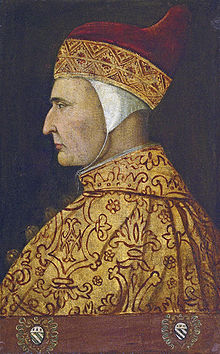Cristoforo Moro (1390 – November 10, 1471) was the 67th Doge of Venice. He reigned from 1462 to 1471.
Cristoforo Moro
| |
|---|---|

Doge Cristoforo Moro (1390–1471)
| |
| 67th Doge of Venice | |
| In office 1462–1471 | |
| Preceded by | Pasquale Malipiero |
| Succeeded by | Nicolò Tron |
| Personal details | |
| Born | 1390 |
| Died | November 10, 1471(1471-11-10) (aged 80–81) |
| Resting place | Sanctuary of the Church of Saint Giobbe |
| Military service | |
| Battles/wars | Ottoman–Venetian War (1463–1479) |
| |

The Moro family settled in Venice in the 5th century when Stephanus Maurus, a great-grandson of Maurus, built a church on the island of Murano.[1] Cristoforo was the eleventh person from the family to be elected doge. His dogaressa was Cristina Sanudo.[2]
After graduating from university, Moro held various public offices. He was the Venetian ambassador to the Popes Eugene IV and Nicholas V. Saint Bernardino of Siena was said to have prophesied that Moro would one day become doge, and as the fulfillment of a solemn vow Moro had the Church of Saint Giobbe built and dedicated to Bernardino's memory. He bequeathed his fortune to various charitable organizations and foundations, including the Church of Saint Giobbe.
Moro's reign was marked by the beginning of a long war between Venice and the Turks. In 1463 Pope Pius II sent Moro a consecrated sword with the intention of convincing Venice to join the anti-Turk alliance. The reaction in Venice was initially hesitant as the Republic's main priority was their economic interests.
In April 1463, 10 years after the conquest of Constantinople, Turkish troops occupied the Venetian fortress of Argos in Greece. The Latin Patriarch Cardinal Johannes Bessarion traveled to Venice to call on the Republic to join the "defense of the faith"; i.e. join the war against the Turks. That same year a coalition was formed between Venice, Hungary and the Albanian prince Skanderbeg with the blessing of the Pope to counter the threat of Sultan Mehmed II's aggressive policy of conquest. The coalition succeeded in temporarily halting Turkish expansion; however, the new territorial limits acquired by the Turks in their conquests had by and large been accepted.
In 1469 the Venetian fleet commander Niccolò Canal retook the town of AinosinThrace, but he was not able to defend the island of Negroponte (Euboea), a major granary of Venice, from Turkish attack. Euboea was conquered by the Sultan while inflicting enormous losses on the Venetian forces.
The Republic faced further threats from the northern Italian cities who coveted Venetian land, as well as from the French king Louis XI who was seeking to expand Lombardy at the expense of Venice.
Moro's tomb is located in the sanctuary of the Church of Saint Giobbe.[3] The tomb is above ground, covered with a marble tombstone.
{{cite book}}: CS1 maint: location missing publisher (link){{cite book}}: CS1 maint: location missing publisher (link)| Political offices | ||
|---|---|---|
| Preceded by | Doge of Venice 1462–1471 |
Succeeded by |